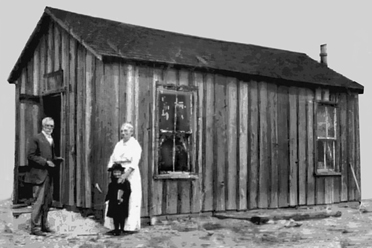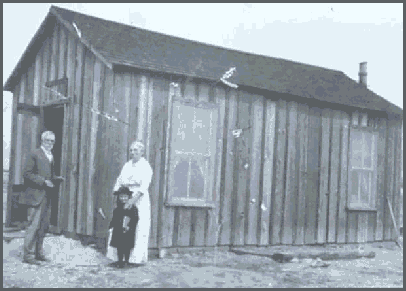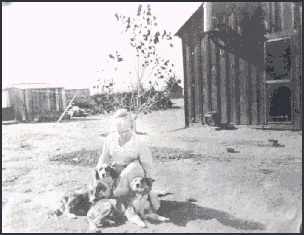A Big House is a Nuisance
The Corwins moved to California from Ottawa, Kansas, where Elmore had a photography studio. His family, consisting of his wife Harriet, son George and daughter Elma, arrived in San Francisco in 1904.
All of them, except Elmore, were still there when the earthquake and fire of 1906 destroyed major portions of the city. Elmore missed that disastrous event because he had moved down to Los Angeles to live with his cousins while looking for work.
After the earthquake the family reunited in Los Angeles, where Elmore had found a job with the Santa Fe Railway. He had been having some health problems, which his doctor attributed to his lungs. If he wanted to live a long life, the doctor advised, he had better move to the desert and get some dry air. This advice apparently was sound, since Elmore lived into his 90s.
Their daughter Elma had recently married, so when the Corwins moved to Apple Valley only 22-year-old George was still living at home with them. Harriet recalled the day they came, declaring that Victorville was no more than "a wide spot in the road." She remembered some of the businesses such as Turner's General Store and Hotel, the railroad station, a restaurant, and a combination saloon and barbershop.
The Corwins drove from Los Angeles in a horse and buggy, and their be longings were shipped to Victorville by rail. They crossed the Mojave River at Hattie and Harry Carden's ranch, which is now part of the Jess Ranch. The Cardens were among the very first to settle in Apple Valley, and they were part of the 1908 Fourth of July picnic that Louvinda Nation described.
Like most other ranchers of the time, the first thing Elmore did was to begin construction of a 16' x 24' barn, living meanwhile in a tent. The building was still unfinished when an early snowstorm blanketed the area, and they had to stretch a carpet over some packing crates in order to create a warm spot for sleeping.
When the barn was completed, sporting a galvanized iron roof, they moved inside and began working on the house. Elmore built a 16' x 32' frame house with three rooms and a good cellar. In the spring of 1910 he began clearing a portion of the farm, planting one acre in apple trees. Each year he planted more trees until in 1913 he had an orchard of about four acres, with another four cleared for future planting.
In September of 1912, while the Corwins were visiting relatives in Los Angeles, a fire destroyed their home. They purchased a replacement house in Apple Valley and moved it to the site, but it was only an 8' x 14' one-room frame structure. Today in Apple Valley there are walk-in closets almost that size, and it is hard to believe they could live in a house that small for any length of time.
Elmore's granddaughter Marian Cain confirmed the house was small, but she recalls there was a living room, kitchen, dining room and bedroom, plus a fairly good-sized basement for storage, where she used to play as a child. Considering Marian's recollections and the fact that Harriet later entertained her social club in her home, it appears that Elmore either added rooms to the house or built a new larger home.
Although the Corwin home was little even for the area, small houses throughout the desert were the norm. Perhaps Elmore and others had the same feelings as expressed by Daggett's Justice of the Peace, T. S. Van Dyke, who wrote of the desert in 1915, "Few imagine that there is a vast area in the United States where a big house is a nuisance and those who have one spend most of their time outside of it both day and night, where people travel more and farther and see more that pleases the eye than in the lands of abundant rain."
In addition to the house and barn there was a 6' x 35' chicken coop, with the hens living in more square footage that the Corwins. Elmore fenced off four acres and piped water in from a well on an adjoining claim.
The total value of all these improvements was $562. To complete the picture of their holdings in 1913, admittedly modest but a start, they owned a cow and grazed two horses on their land.
Index| 1| 2| 3| 4| 5| 6| 7| 8| 9| 10


